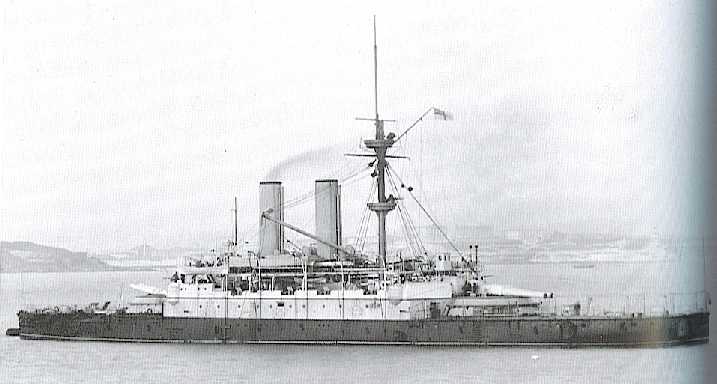
Early breech loaders using black powder for propellant. The Mark I was considered to be the first acceptable large-caliber BL design produced by Woolwich. HMS Colossus was originally to be armed with muzzle-loading 12 inch (30.5 cm) guns but she instead became the first British battleship to have breech-loading (BL) main guns, steel construction and steel armor all in one ship.
The design of these guns was faulty and one burst on trial in HMS Collingwood on 4 May 1886, even though she was firing 3/4 charges. The failure caused the "A" tube to break into pieces in front of the "B" coils. As a result, HMS Colossus was directed not to fire her main guns during her maiden cruise and all of these guns were withdrawn from service to be casehooped. They were then designated as Mark I* and mounted in the "No Man's Land" and "Horse Sand" coastal defense forts at Spithead. The ships were then rearmed with newer, stronger 12"/25 (30.5 cm) guns.
Constructed of steel "A" tube into which the breech-block screwed, a wrought iron breech piece, three "B" coils of which the first was medium carbon steel and the others made of mild steel, one wrought iron "C" coil and a wrought iron jacket. There were no coils over the last 8 feet (2.44 m) of "A" tube at the muzzle end. All of the wrought iron parts were machined from hammer-welded coils. Mark I was a trunnioned gun for use in coastal defense batteries while the Mark II had thrust collars for naval saddle mountings, otherwise the two marks were identical. A total of 5 Mark I and 11 Mark II guns were manufactured.
Actual bore length was 25.13 calibers.
| Designation | 12"/25 (30.5 cm) Marks I and II |
|---|---|
| Ship Class Used On | Mark II: Colossus, Conqueror and Collingwood |
| Date Of Design | 1882 |
| Date In Service | 1885 |
| Gun Weight | 43.8 tons (44.5 mt) inc. breech |
| Gun Length oa | 328.5 in (8.344 m) |
| Bore Length | 301.6 in (7.660 m) |
| Rifling Length | N/A |
| Grooves | N/A |
| Lands | N/A |
| Twist | N/A |
| Chamber Volume | N/A |
| Rate Of Fire | 0.3 - 0.5 rounds per minute 1 |
- ^At target practice in 1887 HMS Colossus made record shooting by getting off four shots from one gun in six minutes and scoring three hits at 1,500 yards (1,370 m) while traveling at full speed (about 16 knots).
| Type | Bag |
|---|---|
| Projectile Types and Weights | AP - 714 lbs. (324 kg) |
| Bursting Charge | N/A |
| Projectile Length | N/A |
| Propellant Charge | 295 lbs. (134 kg) P.Br. (Prismatic Brown - cocoa) 1a |
| Muzzle Velocity | 1,914 fps (583 mps) |
| Working Pressure | N/A |
| Approximate Barrel Life | N/A |
| Ammunition stowage per gun | Collingwood: 85 rounds
Others: N/A |
- ^The original charge was 400 lbs. (181.4 kg) black powder, then reduced to 290 lbs. (131.5 kg) and finally down to 220 lbs. (99.8 kg). This final figure was the charge used when the gun on HMS Collingwood exploded. After rehooping, the charge was changed to the figure and type above.
| Designation | Twin Turret
Colossus (2), Conqueror (1) Twin Barbette
|
|---|---|
| Weight | N/A |
| Elevation | about - 3 / +10 degrees |
| Rate of Elevation | N/A |
| Train 1b | Colossus: 0 / about 170 degrees
Conqueror: -45 / +45 degrees Collingwood: -90 / +90 degrees |
| Rate of Train | N/A |
| Gun Recoil | N/A |
| Loading Angle | 13 degrees |
- ^The Colossus class had their guns in an amidships citadel with the turrets staggered. This allowed them to fire across the beam, although it is not clear if blast effects limited their use in such a manner. They could also fire directly ahead but not directly astern. For the Conqueror class, owing to blast effects on the bridge, it was found to be inadvisable to fire these guns abaft the beam, so the arcs of fire were limited to the figures above. It is noted that Collingwood had no problems from blast effects when firing abaft the beam.
- The guns on these ships could only be loaded when the turret was trained to 0 degrees. The breech end of the weapons were lowered below the deck level by a hydraulic ram and then the charges were rammed into the breech from a compartment outside of the rotating structure.
- The designers worried that the enclosed nature of these turrets would trap propellant smoke, but it was found in practice that the long interval between when the guns were fired and they returned to the loading position gave sufficient time for the fumes to dissipate out the muzzles before the breeches were opened.
"Warrior to Dreadnought: Warship Development 1860-1905" by D.K. Brown
"British Battleships 1889-1904" by R.A. Burt
"British Naval Guns 1880-1945 No 3" article by John Campbell in "Warship Volume V"
"The Big Gun: Battleship Main Armament 1860-1945" by Peter Hodges
"British Battleships: 1860 - 1950" by Oscar Parkes
19 October 2007 - Benchmark
30 January 2009 - Corrected typographical errors
29 August 2010 - Added details about ship design and details of charge weight changes
15 October 2012 - Corrected typographical error
20 September 2016 - Converted to HTML 5 format
31 January 2022 - Additional ammunition data, reorganized notes
